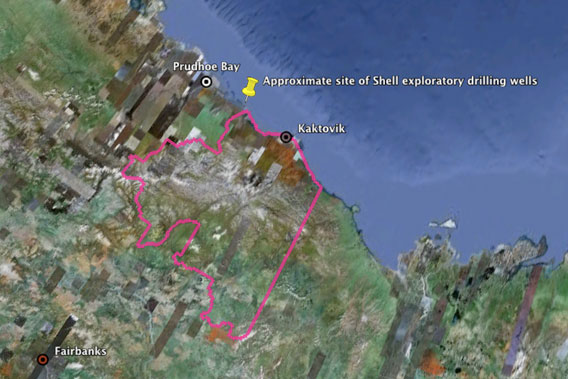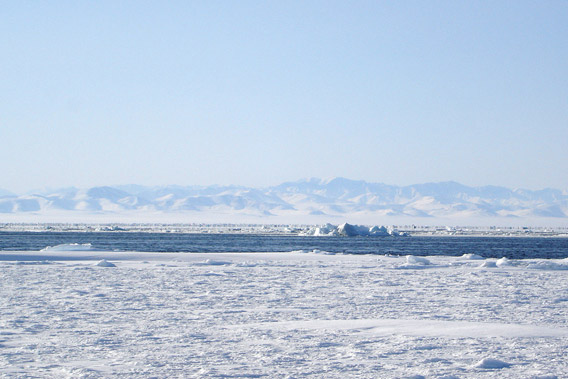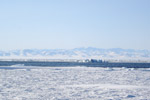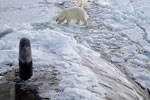
Approximate site of exploratory drilling by Shell in the Arctic’s Beaufort Sea. Pink outline is the Arctic National Wildlife Refuge (ANWR). Shell is also hoping to drill in the neighboring Chukchi Sea. Image made with Google Earth.
Greenpeace has announced that 20 of its activists, stemming from 13 countries, have locked themselves in an icebreaker ship in Helsinki, Finland. The ship is scheduled to move out to the Alaskan Arctic to aid in exploratory offshore drilling by oil giant Shell. Another icebreaker has already left for the U.S. Arctic; both have been leased to Shell by their owner, the Finnish government.
“We are here on behalf of the nearly 400,000 people around the world who in just a couple of months have spoken out demanding that Shell cancel its reckless campaign of Arctic destruction,” Greenpeace campaign manager in Finland Tapio Laakso said in a statement. “Oil companies know full well that an oil spill off the Alaskan coast would devastate the environment and prove impossible to clean up.”
Environmentalists and local indigenous groups are largely critical of Shell’s plans to deal with an an oil spill in extreme Arctic conditions.
“The Arctic Ocean is prone to hurricane-force storms, 20-foot swells, sea ice up to 25 feet thick, sub-zero temperatures and months-long darkness. What’s more, the Arctic has extremely limited infrastructure (there are no roads or deep water ports and only a handful of small airports) and the nearest Coast Guard station is 1,000 miles away,” says Cindy Shogan, Executive Director of the Alaska Wilderness League. One of the largest concerns is that if an oil spill is not cleaned up before winter ice arrives, the oil company would simply have to abandon containment efforts.
In January, a letter signed by 573 scientists urged the Obama Administration to conduct more studies in the Arctic before allowing offshore drilling.
Shell contends that its oil spill plans are the best in the world and it will be able to quickly deal with any spill. However, a recent report by the U.S. Government Accountability Office found that there remain a number of risks to drilling in the remote region.
To date, offshore drilling in the Arctic has been approved by the Obama Administration, which is touting an “all of the above” energy strategy that includes increasing the exploitation of fossil fuels, from offshore oil drilling to fracking, while at the same time providing some support for renewable industries.
While the immediate debate over drilling in the Arctic often focuses on oil spills, climate change is also an issue. The Arctic has suffered the biggest impacts from climate change to date with sea ice vanishing and temperatures rising faster there than anywhere else on Earth. Still, Arctic governments have seen the vanishing ice as an opportunity to further exploit the region for fossil fuels—which will exacerbate global warming—instead of as a sign that climate change must be rapidly tackled.

Arctic Ice Pack, Beaufort Sea. Photo by: Bigstock.
Related articles
Obama Administration, Shell moving ahead with Arctic oil exploitation

(04/02/2012) Last week, the U.S. Department of the Interior approved oil spill clean-up plans by Royal Dutch Shell Oil in the Beaufort Sea, paving the way for offshore oil drilling in the Arctic to begin as soon this year. The Interior’s approval was blasted by environmentalists, who contend that oil companies have no viable way of dealing with a spill in the icy, hazardous conditions of the Arctic, far from large-scale infrastructure. Shell, which has spent $4 billion to date to gain access to the Arctic, must still be granted final permits for drilling.
Arctic warms to highest level yet as researchers fear tipping points

(02/13/2012) Last year the Arctic, which is warming faster than anywhere else on Earth due to global climate change, experienced its warmest twelve months yet. According to recent data by NASA, average Arctic temperatures in 2011 were 2.28 degrees Celsius (4.1 degrees Fahrenheit) above those recorded from 1951-1980. As the Arctic warms, imperiling its biodiversity and indigenous people, researchers are increasingly concerned that the region will hit climatic tipping points that could severely impact the rest of the world. A recent commentary in Nature Climate Change highlighted a number of tipping points that keep scientists awake at night.
Opposition rising against U.S. Arctic drilling
(02/09/2012) Drilling in the Arctic waters of the U.S. may become as contested an issue as the Keystone Pipeline XL in up-coming months. Scientists, congress members, and ordinary Americans have all come out in large numbers against the Obama Administration’s leases for exploratory drilling in the Beaufort Sea and the Chuckchi Sea.
Obama administration opens more of the Arctic to drilling
(10/05/2011) Nearly 500 Arctic oil and gas leases from the Bush administration have been restarted this week by the Obama administration. Known as Chukchi Lease 193, the various leases had been held up in court after environmental groups and indigenous groups challenged them, citing a significant lack of baseline information about the Chukchi Sea ecosystem. The Obama administration now says that many of the ecosystem gaps need not be filled, but Arctic indigenous and environmental groups disagree.
Deepwater spill ‘meets the Titanic’: groups sue to stop Arctic drilling
(09/29/2011) Following the Obama administration’s approval of Royal Dutch Shell to drill in the Arctic’s Beaufort Sea, a wide-swathe of environmental have filed a lawsuit to stop the drilling, which could begin as early as next summer. Those filing the lawsuit today blasted Shell for what they perceived as a pathetic oil spill response plan, and the Obama administration for acquiescing to the big oil company.
Climate change shocker: Canada’s ice shelves halved in six years
(09/28/2011) After the Arctic sea ice extent hit its second lowest size on record this summer—or lowest (depending on the source)—comes another climate change shocker: in the past six years Canada’s millennia-old ice shelves have shed nearly half their size. One ice shelf—the Serson shelf—is almost entirely gone, while another—the Ward Hunt shelf—has split into two distinct shelves. The ice shelves have lost 3 billion tons in this year alone.